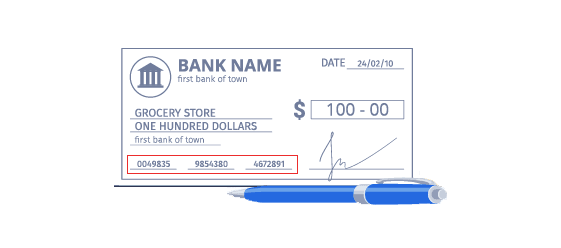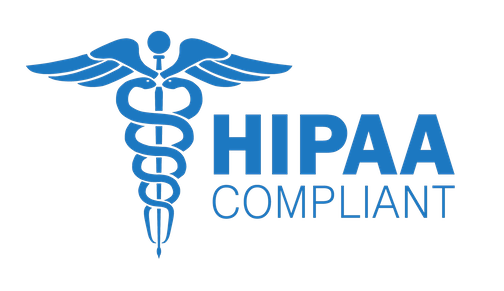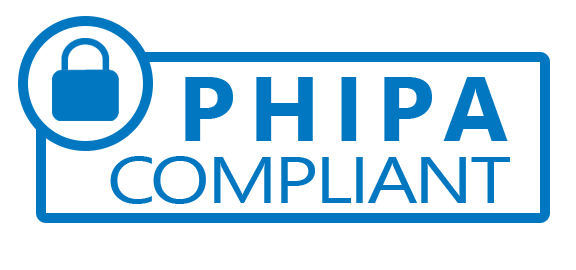
How to Read a Canadian Cheque MICR?
Every bank uses a MICR encoding line to process both US and Canadian cheques. This line provides information about your bank’s branch number, the institution code, account number, cheque number, and sometimes even the transaction code.
We start reading a cheque from its cheque number. It is present in two places, on the top right corner and at the bottom of the cheque. In Canada, this number is always the first element of the MICR line. This number is either 3 or 6 digits instead of US checks with four digits. There’s a transit number in each cheque representing its routing number. It has five digits and corresponds to the home branch where you originally opened your account.
You will also find an institution code of 3 digits next to the transit number. It adds additional information to the transit number representing the Canadian Bank or financial institution. The MICR line also contains a 7-12 digit bank account number. However, the Canadian cheque format ensures that the account number is the last element of the MICR encoding line.
Some cheques also have a transaction code after the account number. It indicates whether a US dollar account is held at a Canadian bank. There are other elements in a Canadian Cheque, such as a name, address, cheque number, date, pay to the order, and memo.
Key Takeaways
- Canadian cheque format is slightly different from US cheques.
- Individuals and businesses must learn how to read a Canadian cheque to simplify their payments.
- The MICR encoding line is everything in both US and Canadian cheques.
- Magnetic ink and font are used to help scanners and processing machines identify and read the line.
- A Canadian cheque consists of a cheque number, transit number, institution code, account number, and transaction code.
- Learning how to read Canadian checks helps in simplifying wire transfers, setting up online payment systems, e-commerce stores, etc.

You can either order your cheques from the bank or print your own cheques. There are several advantages of printing your own cheques using the right Canadian check format. It saves a lot of money and time and is very handy for urgent payments. In order to be able to print your own cheques in Canada, you should be able to read a Canadian check and know its elements closely.
Knowing about the financial tools you are dealing with is always a smart step and can help you in more than one way.
If you have an account with a Canadian bank, are owning a business, or working with a Canadian company, it can be really helpful to know how to read a cheque. This way, you can provide the necessary details to your clients and receive payments. This step will also help you cash cheques, carry out banking transactions, and other related operations. If you are a business owner, you already know how frequently you need to send and receive cheques.
Reading the MICR Encoding Line in a Canadian Cheque
All the banks use the MICR encoding line to process both US checks and Canadian cheques. All the information is stored in this line at the bottom of the cheque. It typically consists of the bank’s branch number (also known as the transit number), the institution code, the customer’s bank account number, the cheque number, and sometimes the transaction code.
The term MICR stands for Magnetic Image Character Recognition. This line is printed using magnetic ink. Moreover, the font used is the MICR font which helps scanners and processing machines identify and read the line. It instantly converts these numbers into digital data that helps banks and financial institutions process these cheques and complete the payments.
There are specific guidelines on how to print cheques and what elements are to be included. Every element has a specific spot on the cheque, which strictly needs to be followed while printing a Canadian check. The MICR line has a lot of valuable information. Let’s know more about its elements and their use.
Cheque number
The cheque number is mentioned in two places, on the top of the cheque towards the right corner and at the bottom of the cheque in the MICR line. The check numbers Canada are placed in the MICR encoding line to inform the bank what number to mention in its customers’ bank statements for every financial transaction that takes place using cheques.
In the US, the cheque number is either placed before or after the routing number or is sometimes placed after the bank account number, but according to the cheque format Canada – this number should always be the first element of the MICR line.
On Canadian cheques, the cheque number is either 3 or 6 digits instead of the US checks with four digits in their cheque numbers. The 3-digit cheque numbers have been popularly used in Canadian cheques for a long time. However, many banks have started to require six digits in the cheque number.
Transit number
The transit number is the routing number in the US checks. It comprises five digits and corresponds to the home branch where the account was originally opened. This number remains the same on all your cheques, irrespective of which branch you are using.
Even if you shift from the city of your home branch and start using a branch in another city, this transit number will remain the same. Unless you close this account and open a new one, this number will remain unchanged throughout the course of your banking activities.
Institution code
The institution code is the next element placed towards the transit number’s right and consists of 3 digits. It provides additional information to the transit number representing the Canadian bank or financial institution with whom you have opened a bank account.
It doesn’t matter if the bank has only one branch or hundreds of branches across the country. It will always have a standard institution code. For example, the institution code for the Bank of Montreal is 001, the Royal Bank of Canada’s is 003, and so on. All branches of a bank use the same institution code.
Account number
Between 7-12 digits of your bank’s account number are written on the MICR line. Your bank defines the number of digits and the format in which it is written, and every bank might use a different arrangement. Some banks use spaces and dashes to separate the numbers, while some use a long number string without any separation.
Hence, it completely depends on the bank. However, as per the Canadian check format, the account number should always be the last element of the MICR encoding line. So, though the bank decides the account number’s arrangement, the layout of the MICR line is still the same for all Canadian banks.
Transaction code
Sometimes, there is a transaction code after the account number. Transaction codes indicate whether a US dollar account is held at a Canadian bank, and when the check is processed, it will be in US funds – which is represented by code 45. The words “US Dollars” or “US Funds” should also be mentioned on the cheque face if the transaction code 45 is included in the MICR line. Several other transaction code numbers are assigned to or used for a specific financial transaction or method of transferring funds.
Reading Other Elements of a Canadian Cheque
Along with the MICR encoding line, there are several other elements of a cheque that you should know if you need to learn how to read a cheque.
Name
This name is of the bank account holder or the drawer of the cheque.
Address
This section is meant to mention the street address of the account holder. The house number or suite number and the street name are mentioned. The layout of the address can be different for different account holders, as per applicability. This information is always printed on the cheque and not written manually. If you wish, you can get your contact number and/or email address added to your checks. The Canada bank check format allows the details to be added just below the address.
Cheque number
We discussed the cheque number above as part of the MICR encoding line. There’s another place where the cheque number is mentioned. The three-digit number mentioned on the top-right corner of the cheque is also the cheque number and is the same as the number below. You would know this if you are aware of how to read cheque numbers in Canada. This number is unique to every other cheque.
 Also Read: Tips to Write A Cheque In Canada
Also Read: Tips to Write A Cheque In CanadaDate
The typical format for mentioning the date of the cheque is YYYY-MM-DD, for instance, 2021-11-07. However, banks can have their own standard format to write the date. Some banks print the format of the date in faded watermarks for you to follow. While printing your cheques, make sure to ask your bank about the acceptable date format. This date indicates on which day the cheque was drawn and is important as the cheque’s validity starts from that date and expires accordingly.
Pay to the order of
The person or company name mentioned on this line represents the bearer of the cheque and is the one who can get the cheque cashed. Basically, the name of the payee is written on this line. If the cheque is meant to be cashed by yourself, the word “myself” is written here.
Be careful with this section and never leave it blank, as anybody can fill up their name and cash the cheque. Moreover, even if you write things like “thank you” or “happy birthday” on this line, the cheque can be cashed by anyone.
Memo
Anything written on this line indicates the reason for payment. For example, you are paying an interior decorator who renovated your office – the words mentioned on the memo line will be “payment for an office renovation.” It reminds the payer and the payee about the reason for payment and comes in handy for your accountant. The memo section helps settle legal disputes, so make sure this section is filled, and the exact reason for making that particular payment is mentioned wisely.

Why is it Helpful to Know How to Read a Canadian Cheque?
You might need to know about the cheque format in Canada for a number of reasons like:
1. Wire Transfers
If someone wants to send money to you via wire transfer, your cheque details will be required. The bank’s transit number, your account number, and the institution code might all be required to make a wire transfer. These details are written on the bottom of your cheque. Make sure to check with your bank, as there might be different numbers assigned for wire transfers. Banks do that to ensure the highest level of security.
2. Setting Up an Online Payment System
Setting up an online payment account like Square, PayPal, Zelle, or Stripe requires you to enter several details related to your bank account. The easiest way to get these details quickly and easily is by having a look at your cheque. If you know about the Canada bank check format and how to read all its elements, your work can become much easier.
3. Setting Up an Online E-commerce Store
For setting up an online eCommerce store, you need to have a merchant account with that particular eCommerce website. For completing this step, you will have to enter all your bank details.
4. For Receiving Payments Through Any Other Online Account
For any other online transactions, mainly receiving payments through other online accounts, it is important that you know your bank’s institution code, transit number, and other details. By knowing about the cheque format and check numbers in Canada, you can easily receive payments.
5. Freelancing
Freelancers need to set up their online accounts, where they can receive payments from their clients. Knowing how to read a Canadian cheque can be really helpful for freelancers in Canada or those who deal with Canadian clients.
6. Assuring Cheque Security
The MICR line at the bottom of the cheque is also meant to enhance your cheque’s security. Although it is for the cheque scanners to read, the line is also clearly visible to the human eye. By cross-checking all the details according to the Canadian cheque format, you can avoid cheque frauds like forfeiting.
7. Printing Your Own Cheques
As discussed earlier, printing your own cheques is very convenient, cost-effective, and quick. You are in control of your own cheque printing process, can add some customizations, and never run out of cheques. By knowing how to read cheque numbers in Canada, you can design your cheques accurately and correctly. You will be able to place the right details in the right places and draft your cheques according to your bank’s standards – which reflects validity and professionalism.
PostGrid‘s print and mail automation platform allows you to draft your cheques according to the bank’s guidelines along with print and mail fulfillment.
8. For Owning a Chequing Account
When you open a Canadian bank account that comes with a chequebook, it is referred to as a chequing account. You can easily make payments for various things like grocery purchasing, paying education fees, house rent, and so on. You can also receive your monthly salary using this chequing account. When you have this type of account and are using a Canadian cheque every now and then to receive and make payments, it is essential that you at least know what’s written on your cheques and what it indicates.
PostGrid‘s direct mail automation platform can help you print and mail your Canadian cheques according to your bank’s standards and guidelines.
 Also Read: Difference Banks Drafts Vs Certified Cheques
Also Read: Difference Banks Drafts Vs Certified Cheques









